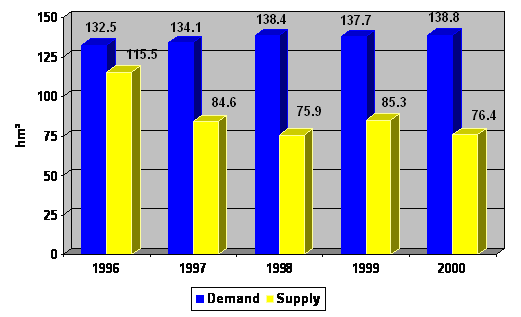Cyprus experiences droughts quite often. Statistical analysis of annual rainfall inland-wide (Figure 12) shows that “dry years” (390 – 470 mm) and “most dry” years (390 mm and less) can be expected to occur every five years. Dealing with drought includes measures to reduce water supply to users, conserve water and increase water availability. Water allocation mechanisms under drought conditions have been set up to provide priority to maintaining domestic and municipal water supplies. The second priority is to maintain supplies to perennial crops at 80% of the recommended application levels. Seasonal vegetable crops are of third priority. Farmers are compensated for the resulting production losses.
During the dry period 1996-2000, a severe shortage in the supply of water was experienced in all sectors, due to consecutive years of low rainfall. The available water in the major dams had reached critical low levels and priority was given for the domestic needs. It has been estimated that the available supplies of water during this period from all the sources at the areas covered by the Government Water Works was on average 87.6 hm3, while the demand for water was calculated to be on average 136 hm3, of which 65 hm3 corresponded to towns and villages and 80 hm3 to irrigation (see figure below).

Water demand & supply balance, 1996 – 2000
Due to the limited availability of water resources, priority was given to cover the domestic needs and in agriculture priority to permanent crops, covering only portion of their water demand. The water allocated to farmers was in the range of 30% to 70% of the normal demand, depending on the type of crop and the availability of water in each project. In some projects the vegetable area was significantly reduced, in order to save water and cover part of the needs of the permanent crops. Various measures were implemented to face the drought situation, such as water supply restrictions, demand management and supply enhancement measures.
Water supply restrictions were imposed on all sectors, leading to a rationalization of water consumption. Eventually, the water shortage was (Savvides, FAO, 2002):
-
23,4% in the domestic sector;
-
37,6% on average in the agricultural sector;
-
23,4% in the industry and animal breeding activities.
These measures raised a number of objections from various social groups, and especially by:
-
Agricultural organizations, which demanded that the farmers should be compensated by the Government for the lost income to the unavailability or shortage of water,
-
Hotel owners, who demanded that the tourist industry should bear either none or a very small restriction of water supply, and
-
Environmental organizations which argued that reducing the quantity and timing of supply of water may not be an effective measure, especially when compared to the dangers these measures inherently have.
The adopted demand management measures addressed to the two major water uses, i.e. the domestic and the irrigation sectors:
- Domestic sector:
- Subsidies for undertaking measures that could save good quality potable water (private borehole drilling, installation of gray water recycling systems in houses, schools, etc.);
- Distribution (free of charge) of sealed plastic bags to be used as displacers in toilet flush tanks;
- Reduction of the “unaccounted for water” in the distribution systems;
- Amendment and strict implementation of Law 1/91, which prohibits the use of hosepipe for the washing of cars and pavements;
- Education and awareness campaigns for the need to conserve water.
- Irrigation sector:
- Subsidies for the installation of rain water collection systems at the roofs of the greenhouses;
- Subsidies for the installation and use of improved irrigation systems;
- Application of a quota system for the allocation of government irrigation water in combination with penalty charges for over consumption;
- No supply of water to new irrigation areas;
- Educational campaigns for better water use and adoption of new less water-demanding crops.
The adopted supply enhancement measures were:
- Desalination:
- Expansion of the capacity of existing desalination plant of Dhekelia from 25,000 m3/day to 40,000 m3/day;
- Acceleration of the process to built and operate a new desalination plant (west of Larnaca) with a capacity of 52,000 m3/day.
- The main aim of the policy towards desalination was to eliminate the dependency of urban centres and tourist areas on the unpredictability of rainfall, and thus ensure that water is provided on a continuous basis to households. The environmental NGOs, however, were against this measure due to the high water production costs and environmental concerns.
- Use of recycled water for irrigation. Farmers were initially reluctant to use recycled water for irrigation, as this was the first time recycled water was being used commercially at such large scale. However, the acute water scarcity faded out the objections.
- Emergency measures to temporarily increase the supply of water for drinking purposes in urban and rural areas. This included the sinking of wells, the requisition of private boreholes and water transfer using pipes or trucks.